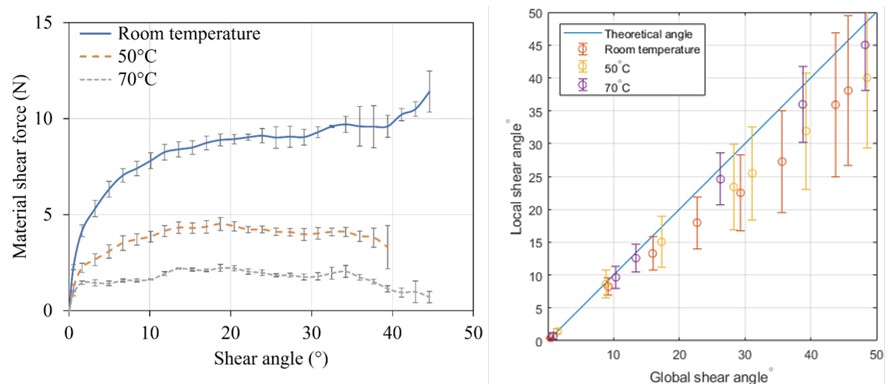Bohao Zhang and Byung Chul Kim*
The continuous tow shearing (CTS) process is an advanced automated fibre placement technique with the capability of steering unidirectional prepreg tapes using in-plane shear deformation, without generating tape buckling, gaps and overlaps which can be commonly seen in conventional automated fibre placement process. However, the inherent fibre misalignment within the tape can induce fibre waviness during the CTS process, which is affected by processing parameters such as temperature, shear strain rate and fibre tension. It is of importance to characterise the shear response of the prepreg tapes subjected to large shear deformation by considering the operation processing parameters used in the CTS process.
Two commonly used test methods to characterise the in-plane shear deformation of composite materials, i.e., the picture frame and bias extension tests, are not suitable for characterising unidirectional prepreg tapes. Alternatively, the off-axis tension test could be used, but specimens can only be sheared to small shear angles. Therefore, in this work, a bespoke test fixture was designed to shear unidirectional prepreg tapes at various shear strain rates and fibre tensions (see Fig. 1 which shows the working mechanism of the test fixture) and investigate the effect of shearing conditions. Digital image correlation (DIC) was used to obtain full-field strains of the specimens and to investigate the fibre realignment during shearing.

Figure. 1. The bespoke in-plane shear test fixture used for shear deformation of a specimen. The image shows the specimen before (a) and after (b) shear deformation.
The experimental results (see Fig. 2) showed that temperature is critical to the fibre realignment during shearing, as the viscosity of the resin matrix significantly influence the level of fibre re-arrangement during the shearing process, determining the shear resistance of the tape material. Thus, the local shear angle measured by DIC became closer to the global shear angle as the temperature increased. (The blue line in Fig. 2(b) is the ideal condition where the local shear angle is the same as the global shear angle, reflecting a perfect shearing.) The shear rate effect was almost negligible when the temperature was sufficiently high due to the reduction of the resin viscosity. High fibre tension allowed fibres to maintain the straightness during shearing. For the CTS process, an optimal processing temperature should be firstly determined. However, its impact on the tackiness of the resin for deposition and adhesion between the prepreg tape and the backing paper should be considered. A high fibre tension is preferable, but it requires a more robust structure of the deposition system.
Please refer to the original paper for more details. (https://doi.org/10.1016/j.compositesa.2022.107168)

Figure. 2. Effect of temperature: (a) average material shear force vs. shear angle and (b) local shear angle vs. global shear angle for IM7/8552 specimens.
